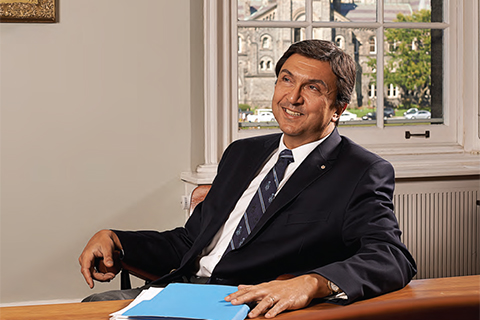Over the next 15 years, the number of students attending university in Ontario is expected to grow by 120,000 – or more than 30 per cent. Growth will be especially fast in the Toronto region, and many students will want to stay close to home. That’s a splendid recruitment opportunity for U of T.
It’s also a trap. Our long-standing pattern of skimming the best undergraduates from the Toronto region has paid handsome dividends with a dynamic and talented student body. But in some respects, it has restricted our reach and our diversity. Last year, for instance, almost 75 per cent of the students entering an undergraduate program at U of T came from the Greater Toronto Area. Repeating that pattern means we will continue to draw a very high proportion of commuter students who, on average, are understandably less engaged with on-campus life.
At the graduate level, the story is different. The GTA yields 60 per cent of our graduate students, but 25 per cent come from outside Ontario and 15 per cent from abroad. Our professional faculties are even more geographically diverse. Fewer than half of all architecture students and about half of all law students come from the Toronto area.
There’s a lesson there. Our global reputation is driven primarily by our research intensity and our professional and graduate programs. And, judged by research productivity, citations and achievements – as well as discipline-specific measures of our reputation among academic peers worldwide – we remain the top university in Canada. One example: overall rankings of universities are by and large a mug’s game, but the Academic Ranking of World Universities at least has stayed with one set of methods and rejected the usual tossed salad of “adjusted” scores. By that measure, we are consistently number one in Canada, with the University of British Columbia in second and McGill a distant third.
As I’ve noted before, the key challenge for U of T is to share that excellence with our undergraduate students, and we still have work to do. With rapid enrolment growth in recent years, student-faculty ratios rose, more students with B+ high school averages were admitted to first year and undergraduate students have given us some mediocre grades on measures of satisfaction and engagement.
Better services and more resources would help resolve some of these issues. But we should also consider how enrolment affects the student experience. After all, who is more likely to be satisfied and engaged? A commuting student who has little time to spend at U of T outside of classes, or a student living on or near one of our three campuses?
These and related questions are now being raised by a high-level task force on enrolment, launched under the auspices of our “Towards 2030” strategy-setting exercise. Among the related questions: How much more growth can U of T accommodate on each of its three campuses? And, perhaps the toughest of all: Are entering grades the sine qua non of student excellence? If not, what other attributes matter in undergraduate recruitment?
Once we’ve clarified our strategy, the harder work of implementation begins. Better communication with high school guidance counsellors, advertising, visits to selected schools, involving local alumni in recruitment – these are part of the picture. Growth in our scholarship programs is also a priority. Currently, the university bestows some 1,400 admission scholarships – valued at a few hundred to several thousand dollars – to the top incoming students each year. Yet fewer than 400 students receive scholarships valued at the level of tuition in first year.
Traditionally, alumni have been tremendous supporters of scholarships and awards. They have also been telling me, in one city after another, that if we are prepared to launch a more proactive recruitment strategy, they will be ready to help us draw more of the best and brightest high school students to U of T from across Canada and around the world. For that, and for your continued support, my deepest thanks. We’ll be calling on you as our long-term planning exercise draws to a close in the months ahead.
Sincerely,
DAVID NAYLOR







No Responses to “ GTA Overload? ”
President David Naylor states that students from the GTA account for almost 75 per cent of U of T’s undergraduate enrolment, and that demand for a university education in Ontario is expected to rise dramatically.
I was appalled to read that U of T is considering an enrolment strategy that will favour students who can afford to live on campus. Even middle-income families struggle to meet rising tuition costs. My children will not be able to afford to live on campus. U of T’s policy should focus on increasing capacity to support commuting students, which is a way of life in the GTA. If accessibility to education declines, U of T will not remain a top university. Please reconsider U of T’s future undergraduate enrolment policy.
Deborah Ellen Wildish (née Boyko)
MA 1995
Mississauga, Ontario